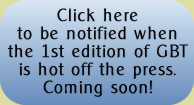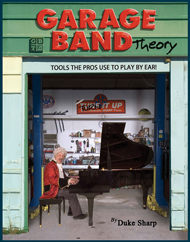What's In It For Me?
If you play by ear now, but want to be able to 'talk-the talk', Garage Band Theory will get you there! If you can already read music and know some basic theory but haven't quite figured out how to play by ear, Garage Band Theory will help you make the connections. GBT brings a new approach to learning (and teaching) music! Until now, if you wanted to learn to play an instrument, you had to choose between learning to Most of what you find on sales racks are method books for specific instruments... guitar, piano, banjo, etc. Garage Band Theory covers nearly all instruments, and merges playing by ear with traditional theory. It’s an all-inclusive guide that’s easy to understand and easy to use. Written by a guy who has taught and played professionally for 30 years, it’s filled with illustrations (standard notation and tablature), practical exercises, chapter quizzes, and inspiring quotes, as well as links to artists, Jammer Pro and Finale files, and free downloads. There's a GBT YouTube channel with videos of original artists playing the songs you'll find in Garage Band Theory. Here is a recap of what you get when you order GBT:
Multi-genre approach - Dozens of musical examples provide lots of variety, which makes you more musically well rounded. Traditional tunes have a place in learning to play by ear, but nobody really wants to learn Go Tell Aunt Rhody. In addition to Christmas carols and songs from the public domain, GBT presents nearly 100 popular tunes by JS Bach, Beethoven, Irving Berlin, Grateful Dead, George Gershwin, The Beatles, Cole Porter, Willie Nelson and Mark Knopfler, among many others. The traditional music included illustrates foundational theory that is understood around the globe. At first, it's much easier to figure out songs like Auld Lang Syne, Silent Night and Happy Birthday than it is to tackle more exciting material, so there are plenty of these traditional tunes in GBT. When you're ready for it, there's plenty of the exciting stuff too. Chapter quizzes and an answer key allow students to measure progress so they can tell if they are learning or not — great for families learning in a home-school environment. For most people, physical skills develop slowly and it's sometimes tough to measure progress — and that can be frustrating. The concepts and vocabulary presented in GBT aren't difficult and aid in all areas of the music education experience. Even if you don't have any musical background, the quizzes and answer key let you lead your young musician through a comprehensive program. Did you ever wish you could actually hear the notes on a page of music? With Garage Band Theory... YOU CAN! Notation examples in GBT were created in Finale. FinaleNotePad is a free download that lets you hear the written examples. Download the Finale files and you can hear the written music in GBT. Tablature for guitar, mandolin, banjo as well as standard notation for keyboards, brass and woodwinds - The author is primarily a guitarist and while teaching, most students were learning guitar. Tablature is less intimidating for guitar, mandolin and banjo students, so there is plenty of tab. But tablature is irrelevant for piano students, the horn section, vocalists and percussionists, so everything is in standard notation as well as tab. If you don't know standard notation, tablature is the way to go. It is a picture of the notes, and a single picture is worth a thousand standard notes if you can’t read them! Two sets of tabs for guitar - It can be frustrating when books show a song or a riff in only one location on the neck, because it can sometimes take quite a while to figure it out in a different key. In most cases GBT supplies two different guitar tabs. Not only can you try it out right away, it makes it clear that most things can be played in more than one area of the neck, and that's an important concept that is often overlooked. Shaded fret boards are visually friendly and add utility. In addition to tab and notation, there are often chord diagrams for guitar and mandolin. Although a fret board can be seen as a graph, chord diagrams can be difficult to understand at a glance. It’s easier 'grab' a chord quicker when the diagrams are shaded to correspond with the dots that are on most guitar fret boards. Environmentally friendly - Most instructional books are so tightly focused on a single instrument and a single phase of the process that once you've been through it it's useless, and you have to purchase another. If you work all the way through a guitar series, you'll have purchased more pages than GBT contains, and if you want to learn mandolin or banjo you start the process over. While that's good for the publisher, it’s bad for your wallet — and the environment. If two people in the home are learning different instruments, they can share one copy of GBT. Saves you money and they'll learn the same vocabulary and songs. In addition, GBT is printed on recycled paper. Great for Teachers! GBT is a great supplement for existing lesson plans. It can be used as a stand-alone book on which to base a year's worth of lessons, but if you already have a program that works, having students work through the book on their own will accelerate their progress. Many times when I was teaching, something would interfere with my daily lesson plan and I’d have to wing it. With GBT on your shelf you'll always have something interesting you can use. GBT does not use the traditional sequence for the introduction to theory. It was written with the specific goal of getting to 'how to play by ear' as quickly as possible and the classical presentation of basic theory is not intended to address that approach to playing music. Many adult students express the desire to learn “a little theory.” There are lots of people with fairly advanced physical skills who have virtually no corresponding vocabulary. One frustration for me when I was teaching private lessons was that it was difficult to find time during a lesson to do anything except focus on the piece at the top of the list, and relevant vocabulary was usually skipped. Often, students have questions, but they don't have enough vocabulary to phrase them. If they do manage to articulate the question, there is often not enough shared vocabulary to answer. An expanded musical vocabulary will allow students to ask the questions they want answers to. GBT assumes no previous music knowledge, but encompasses a fairly high level of theory, so lessons are useful for readers at all levels. Makes current library accessible - Lots of people have purchased method and theory books over the years, but reach a point where they’re unable to continue, usually due to lack of vocabulary. GBT will provide definitions and examples to make that existing library useful. Beginner to advanced lessons, so you can use it to learn and to teach for a long time.As I was developing the chapters on chords, I realized that once someone understands the simplest chords, it's a very short step to the advanced concepts. A beginning student can easily comprehend advanced ideas, even if they can't play them. Many of the exercises were developed because I wanted to learn them myself. The GBT YouTube Channel has videos with the original artists playing the songs used as examples in GBT. GBT is all about learning to play by ear, and to do that you have to listen to the music. What could be better than watching the Temptations do My Girl, or Santana do Black Magic Woman when you're starting to learn it? There are dozens of videos on the GBT YouTube channel that show the original artist performing the tunes used as examples. You can watch Fats Waller playing “Ain't Misbehavin,” The Jerry Garcia Band playing “Deal” and Hear Ray Charles sing Georgia even if you're not learning to play, check it out )
Keyboard illustrations - A keyboard is the best visual reference when explaining many concepts, so GBT includes plenty of them. Hundreds of standard notation illustrations - Most music instruction books are produced by corporate publishers interested in keeping printing costs at a minimum, so they provide a minimum number of examples. As a student and a teacher I realized that it often takes two or three different examples of a concept before it's really clear, so GBT is chock full of ‘em. Free downloads of traditional tunes. I've recorded several of the songs included in GBT, and most of them are available for free downloading. Easy to use - Spiral binding allows the book to lay flat on a music stand, a table or the floor. The text and examples are large, so you can set the book down and sit or stand at a comfortable distance while holding an instrument. User-friendly page layout - Musical examples are visible while you are reading the explanation. Have you ever read an instructional manual where the thing being described is illustrated in a different part of the book, so you have to flip back and forth? You won’t need to do that with GBT. In music theory, everything is connected to everything else, so 'non linear' learning is a common component. There are lots of places where ideas in other chapters are mentioned — it's easy to flip to the referenced page, because chapters and page numbers are easily visible. Jammer Pro Files - Throughout GBT, you're encouraged to take existing music and twist it, play it a little bit differently, make it your own. This can be difficult at first, but the Jammer Pro files included (nearly 200) make it a lot easier. Want to hear how a reggae band would sound playing Bach's ‘Bouree in E Minor’? How a bluegrass band would sound playing ‘Somewhere Over The Rainbow’? If you feel like jamming to Purple Haze with a backup band that can do it as a samba or a polka, you can do that with a couple of clicks. Large fun! Download the free Jammer Pro Demo and you can speed them up, slow them down, change band styles, or change keys. You can hear the music, and concepts like transposing, etc. are instantly clarified.
Links to artists mentioned in GBT. I’ve been inspired by lots of musicians, philosophers, authors and friends. The Cast of Characters page has links to nearly 200 websites and Wikipedia pages. Humor makes learning more enjoyable.The author is not a professor; he's a honky-tonk musician and a river-rat who has been a compulsive reader since he was five. The style is friendly and conversational, with enough light humor to make it an enjoyable read. Get clued in - Explanations and technical words are described before they are used.
Inspirational quotes are encouraging and help develop persistence. Most music instruction books offer a shortcut to learning to play music. Truth is, it's a long process that requires years of dedication. There are plenty of opportunities to become discouraged. While writing the book there were times these quotes kept me going when I really wanted to give up. History makes learning more interesting and engaging. Until I began digging for examples, I didn’t know Mozart composed an amazing set of variations on “Twinkle, Twinkle, Little Star.” Everyone knows this tune, so it’s great for shared understanding worldwide. I was fascinated by the background of music like Beethoven's Moonlight Sonata, traditional songs like “Pop Goes The Weasel”, “Take Me Out To The Ballgame” and “Silent Night” and you'll find stories about these songs and many others in GBT. Scale exercises strengthen your chops. Lots of great players recommend scale exercises as the quickest way to develop strength and coordination, but most method books contain few, if any exercises. GBT has several pages of exercises in both notation and tab, as well as ideas to help you expand on the exercises provided. Plus, by using Finale Reader, you can hear what they should sound like, then slow them down so you can play along. Valuable reference resource - Most instructional books or series want you to think that they somehow have all the answers, and frankly, that's impossible — music is too vast a topic. There are several instructional books I found useful and a great value, so I recommend them.
Practical practice tips - If you’re already an accomplished musician, you’ll still find GBT a valuable resource to keep your playing fresh. I'm not a beginner, and there are sections I use for practice on a rergular basis. This book was written specifically to explain a process of playing by ear, and how to apply that to jamming with your friends and family. I was surprised to discover that the only way to do that was to use traditional music theory. Clearly, there is really no product in the marketplace that compares to Garage Band Theory! There are books that offer traditional theory, and even books on play-by-ear approaches, but none that are geared towards multi-instrument, multi-genre use, offer both modern and traditional examples, encourage the reader and are written in a light hearted, humorous and engaging style. You can even download a free trial copy, and pay for it after you've had a chance to look it over, so what have you got to lose? Order your copy today and start learning to play by ear! |
 |




